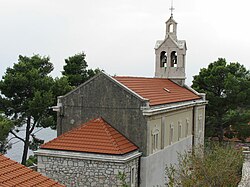Sveta Nedjelja Sveta Nedija Sveta Nedilja | |
|---|---|
Village | |
 Church of Sveta Nedilja | |
| Coordinates: 43°08′10″N16°35′20″E / 43.13611°N 16.58889°E | |
| Country | |
| County | Split-Dalmatia |
| Town | Hvar |
| Area | |
• Total | 4.6 km2 (1.8 sq mi) |
| Population (2021) [2] | |
• Total | 135 |
| • Density | 29/km2 (76/sq mi) |
| Time zone | UTC+1 (CET) |
| • Summer (DST) | UTC+2 (CEST) |
| Postal code | 21465 |
| Area code | +385 (0)21 |
Sveta Nedjelja [3] also known as Sveta Nedilja (Chakavian dialect: Sveta Nedija), is a small village on the Croatian island of Hvar. It is located near the town of Hvar and it has 135 residents (2021). [4]
